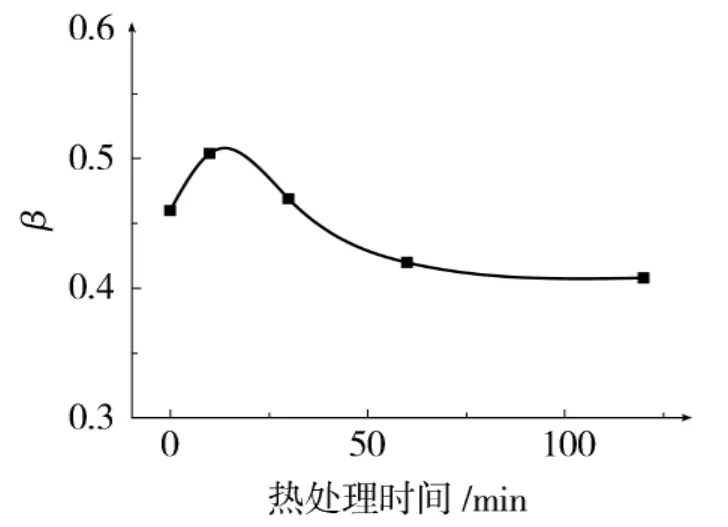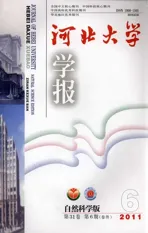玻璃态PS焓松弛β参数的热历史依赖性
2011-12-09李丽霞赵冬梅范留彬刘国栋
李丽霞,赵冬梅,范留彬,刘国栋
(河北工业大学 高分子科学与工程研究所,天津 300130)
玻璃态PS焓松弛β参数的热历史依赖性
李丽霞,赵冬梅,范留彬,刘国栋
(河北工业大学 高分子科学与工程研究所,天津 300130)
用TNM模型研究了PS的焓松弛,将模型参数Δh,x和lnA作为材料常数,假定β参数随热处理条件变化,提出了新的参数优化方法:由极限假想温度Tf′求取Δh;由Tf′和峰值温度Tmax求取x和lnA,不同热处理条件下的β值由对归一化比热CNp数据进行拟合得到.Tf′,Tmax和CNp的理论计算值都与实验结果十分接近,得到的参数具有规律性,β随热处理条件变化,当降温速率从100K/min降到0.1K/min时,β从0.498降到0.341,在363.15K下恒温老化,随老化时间延长β呈现极大值0.504,从结构松弛的角度对上述结果进行了解释.
PS;β参数;玻璃化转变;焓松弛;热历史
聚合物在玻璃化转变附近的焓松弛和物理老化一直都是高分子领域的重要研究课题,它不仅影响到聚合物的力学性能,而且与对玻璃化转变本质的认识密切相关[1-2].对于一个偏离平衡态的聚合物,无论是在恒温还是在升降温的条件下,它都会向热力学平衡态转变,但是在玻璃态时这个过程速度很慢,是一个松弛过程,具有非指数和非线性的特点.非指数特性通常采用KWW松弛方程描述[3]

式中t为时间,τ为松弛时间,参数β是介于0到1之间的正数,由松弛时间分布决定.松弛时间τ具有结构和温度依赖性,过去几十年间,学者们进行了大量的研究,建立了很多模型用以描述松弛时间对材料结构的依赖性,如 TNM 模型[4-6],AG 模型[7],GR模型[8]等,其中 TNM 模型应用的最为广泛

式中A和Δh为模型常数,参数x(0<x≤1)为非线性指数,当x=1时,松弛呈现线性特征,R为理想气体常数,T为温度,Tf为假想温度,由下式求取

其中T1为高于玻璃化温度Tg的某一温度,Cpr,Cpg和Cp分别为橡胶、玻璃和实际材料的等压比热.
模型参数可以给出分子运动的信息,有研究表明聚合物化学结构、分子质量及分布等对参数β有重要影响,但是对于同一种聚合物聚苯乙烯(PS),报道的β在0.39到1之间变化.对于同一种样品的焓松弛研究表明,降温速率、老化温度、老化时间等对参数也有影响,但是目前的研究结果又存在矛盾.随老化温度降低,Cowie和Sastry报道β减小[9-11],但是Alegría报道β基本不变[12];随老化时间延长,Tribone和 Hodge认为β不变[13-14],Oudhuis发现β单调增大[15],Vidal Russell则报道β减小[16],Alegría报道β有极大值[12].研究表明,β的最优值不仅受热历史影响,还与Δh的取值密切相关[13,17],在聚合物的焓松弛参数与热历史关系研究中,研究者通常假定其中某一个参数,lnA或者Δh,与热历史无关,而认为其他参数随热历史变化,或者认为所有参数均具有热历史依赖性[13-14,18-19].在TNM模型中,Δh,x和lnA描述焓松弛时间的结构依赖性,应是材料的本征参数,然而β具有不同的物理含义,与材料结构相关,依赖于热处理过程.但是目前未见有关β与材料结构关系的研究报道,本文即以此为出发点研究PS焓松弛过程中β与热历史的关系.
1 实验、计算与拟合过程
1.1 样品测定
PS采取本体聚合方法制备,由Polymer Lab GPC 220测定其数均分子质量为5.26×104g/mol,分散
1.2 计算与拟合

其中T0是测试的起始温度,对式3进行微分可以得到[20]
由式1、式2结合Boltzmann叠加原理即可获得任一时刻样品的Tf



根据极限假想温度Tf′与降温速率q的关系[6]

以ln|q|对1/Tf′作图即可得到Δh/R为(113.8±5.4)kK,如图1所示,高于Hodge报道的(79±10)kK[21],但是笔者的Tf′变化范围为8.0K,远大于Hodge的3.6K,所以可信度更高.

图1 不同降温速率PS的lnq~1/Tf′关系Fig.1 Experimental variation of 1/Tf′with lnq



在升降温过程中步长为1/3K,恒温阶段按等比分成50个时间间隔,x,lnA和β的最小步长分别为0.001,0.01和0.001.
2 结果与讨论
2.1 拟合结果
如图2所示,Tf′随降温速率减小和老化时间延长而降低,Tmax随降温速率减小呈现不太明显的极小值,但是随老化时间延长而单调升高,Tf′和Tmax的理论预测值都与实验结果十分接近,基本都小于测定误差,远远小于Hodge的预测误差[13].

图2 Tf′和Tmax的实验结果与预测值Fig.2 Experimental and predicted Tf′and Tmax

图3 不同降温速率和不同热处理时间后PS升温的实验结果与理论值Fig.3 of PS recorded after cooling from 423.15to 273.15Kat different cooling rates and annealing times
2.2 降温速率对β的影响
图4是不同降温速率下的β值,与其他研究者对PS焓松弛研究得到的0.677和0.45~0.63[21-22]基本一致,随降温速率从100降到0.1K/min,β值由0.498降至0.341,这种趋势与Hodge固定Δh/R为63和80kK时的趋势相反.Cowie和Sastry研究表明β随老化温度升高而增大[9-11,20,23].Alegría认为偏离平衡态的系统β应该略高于玻璃态[24],由此可以认为橡胶(液体)具有最窄的松弛时间分布,所以β最高,而玻璃的松弛时间分布最宽而具有最小的β,材料的β随状态而变化,但是在所有的拟合过程中均假定β不随热处理过程变化,因此得到的β只是一个统计平均值.如图5所示,随降温速率变小,聚合物的Tf′降低,因此在升温中的松弛过程更加接近理想玻璃体,具有更低的β值,而且样品具有更高的Tg使得样品在更长的时间段内处于玻璃态,使得总体呈现低的β值,所以,PS的β随降温速率降低而变小.Andreozzi和Privalko认为分子量对β有重要影响并将其归因于分子量减小使得松弛时间分布变窄[2,22],事实上,分子量降低聚合物的Tf′和Tg都降低,所以在同样的测试条件下样品更多地处于橡胶态可能才是β增大的根本原因.

图4 不同降温速率的最优β值Fig.4 Best-fitβof PS after cooling from 423.15to 273.15Kat different rates

图5 降温升温过程中聚合物的假想温度Fig.5 Fictive temperature of polymer during cooling and heating course
2.3 老化时间对β的影响
图6为β随363.15K下热处理时间的变化规律,可以看到随时间延长,β先增加后降低,这与Tribone报道β与热处理温度和时间无关不同,但是与Alegría和Russell的恒温松弛实验结果一致[12,16].这是由于在恒温老化过程中(图7),材料结构逐渐向平衡态松弛,与此同时,松弛时间分布逐渐变窄,β增大,当老化时间继续延长,虽然恒温时间段β进一步增大,但是材料在后续的降温和升温阶段由于更加接近理想玻璃态而具有更小的β值,因此导致随老化时间延长PS的β出现极大值后反而降低.

图6 363.15K下热处理不同时间后PS的最优β值Fig.6 Best-fitβof PS after annealing at 363.15Kin different time

图7 热处理过程中聚合物的假想温度Fig.7 Schematic plot of Tfvs Tin annealing
3 结论
基于TNM模型参数的物理意义,提出了处理聚合物焓松弛数据的新方法,即由极限假想温度Tf′确定Δh,由Tf′和Tmax确定x和lnA,最后由CNp曲线求取不同老化条件样品的β参数,对PS数据的研究表明预测值与实验结果较为接近,热历史对β具有明显的影响,当降温速率从100K/min降到0.1K/min,β从0.498降到0.341,随老化时间(365.15K)延长β出现极大值0.504后逐渐降低.
[1]PAN P J,ZHU B,INOUE Y.Enthalpy relaxation and embrittlement of poly(l-lactide)during physical aging[J].Macromolecules,2007,40(26):9664-9671.
[2]ANDREOZZI L,FAETTI M,GIORDANO M,et al.Molecular-weight dependence of enthalpy relaxation of PMMA of the pseudostereochemical equilibrium approach[J].Macromolecules,2005,38(14):6056-6067.
[3]WILLIAMS G,WATTS D.Non-symmetrical dielectric relaxation behaviour arising from a simple empirical decay function[J].Trans Faraday Soc,1970,66:80-85.
[4]TOOL A Q.Relation between inelastic deformability and thermal expansion of glass in its annealing range[J].J Am Ceram Soc,1946,29(9):240-253.
[5]NARAYANASWAMY O S.A model of structural relaxation in glass[J].J Am Ceram Soc,1971,54(10):491-498.
[6]MOYNIHAN C T,EASTEAL A J,BOLT M,et al.Dependence of the fictive temperature of glass on cooling rate[J].J Am Ceram Soc,1976,59(1):12-16.
[7]HODGE I M.Adam-Gibbs formulation of nonlinearity In Glassy-state relaxations[J].Macromolecules,1986,19(3):936-938.
[8]GOMEZ RIBELLES J L,MONLEON P M.Structural relaxation of glass-forming polymers based on an equation for configurational entropy.1.DSC experiments on polycarbonate[J].Macromolecules,1995,28(17):5867-5877.
[9]COWIE J M G,FERGUSON R.Physical aging studies in poly(vinylmethyl ether).I.enthalpy relaxation as a function of aging temperature[J].Macromolecules,1989,22(5):2307-2312.
[10]COWIE J M G,HARRIS S,MCEWEN I J.Physical ageing in poly(vinyl acetate)1.enthalpy relaxation[J].J Polym Sci B Polym Phys,1997,35(7):1107-1116.
[11]SASTRY S,DEBENEDETTI P G,STILLINGER F H.Signatures of distinct dynamical regimes in the energy landscape of a glass-forming liquid[J].Nature,1998,393(6658):554-558.
[12]ALEGRIA A,GOITIANDIA L,TELLLERIA I,et al.Alpha-relaxation in the glass-transition range of amorphous polymers.2.influence of physical aging on the dielectric relaxation[J].Macromolecules,1997,30(13):3881-3887.
[13]HODGE I M.Effects of annealing and prior history on enthalpy relaxation in glassy polymers.6.Adam-Gibbs formulation of nonlinearity[J].Macromolecules,1987,20(11):2897-2908.
[14]TRIBONE J J,O'REILLY J M,GREENER J.Analysis of enthalpy relaxation in poly(methy1methacrylate):effects of tacticity,deuteration,and thermal history[J].Macromolecules,1986,19(6):1732-1739.
[15]MESEGUER D J M,GARAYO A V,ROMERO C F,et al.Structural relaxation of glass-forming polymers based on an equation for configurational entropy,4.structural relaxation in styrene-acrylonitrile copolymer[J].J Polym Sci Part B Polym Phys,1997,35(14):2201-2217.
[16]RUSSELL E V,ISRAELOFF N E.Direct observation of molecular cooperativity near the glass transition[J].Nature,2000,408(6813):695-698.
[17]HODGE I M.Effects of annealing and prior history on enthalpy relaxation in glassy polymers.4.comparison of of five polymers[J].Macromolecules,1983,16(6):898-902.
[18]LUTHRA S A,HODGE L M,PIKAL M J.Effects of annealing on enthalpy relaxation in lyophilized disaccharide formulations:mathematical modeling of DSC curves[J].J Pharm Sci,2008,97(8):3084-3099.
[19]OUDHUIS A,BRINKE G T.Enthalpy relaxations and concentration fluctuations in blends of polystyrene and poly(oxy-2,6-dimethyl-1,4-phenylene)[J].Macromolecules,1992,25(2):698-702.
[20]COWIE J M G,FERGUSON R.Physical aging studies in polymer blends.2.enthalpy relaxation as a function of aging temperature in a poly(vinyl methyl ether)/polystyrene blend[J].Macromolecules,1989,22(5):2312-2317.
[21]HODGE I M.Effects of annealing and prior history on enthalpy relaxation in glassy polymers.3.experimental and modeling studies of polystyrene[J].Macromolecules,1983,16(3):371-375.
[22]PRIVALKO V P,DEMCHENKO S S,LIPATOV Y S.Structure-dependent enthalpy relaxation at the glass transition of polystyrenes[J].Macromolecules,1986,19(3):901-904.
[23]BRUNACCI A,COWIE J M G,FERGUSON R,et al.Enthalpy relaxation in glassy polystyrenes:1[J].Polymer,1997,38(4):865-870.
[24]ALEGRIA A,GUERRICA-ECHEVARRIA E,GOITIANDIA,et al.Alpha-relaxation in the glass-transition range of amorphous polymers.1.temperature behavior across the glass-transition[J].Macromolecules,1995,28(5):1516-1527.
Thermal History Dependence of Kohlrausch Parameterβin Enthalpy Relaxation of Glassy Polystyrene
LI Li-xia,ZHAO Dong-mei,FAN Liu-bin,LIU Guo-dong(Institute of Polymer Science and Engineering,Hebei University of Technology,Tianjin 300130,China)
Structural relaxation and physical aging of glassy polymers are important topics in polymer science.The relaxation was characterized by nonexponentiality and nonlinearity.The enthalpy relaxation of PS was restudied by adapting TNM model in this paper.Δh,xand lnAwere assumed to be material constants whileβto be a thermal history dependent parameter.Based on this assumption,a new optimizing method was proposed.Δhwas obtained by fitting limiting temperatureTf′,xand lnAwere obtained by fittingTf′andTmax,while the individualβwas obtained by fitting the normalized heat capacitiesCpN.The fitting results of bothTf′,TmaxandCpNwere perfect well.The best-fitΔh,xand lnAwere obtained to be 114kK,0.247and-300.72s-1,respectively.βwas found to be thermal history dependent.It decreased from 0.498to 0.341when the cooling rate deceased from 100to 0.1K/min while showed a maximum of 0.504with the increasing annealing time at 363.15K.The observed result was tentatively interpreted by conceiving thatβchanges along the thermal treatment and the obtained value maybe an apparent one.The apparentβmay be determined byTf′andTgof the sample with different thermal history as well as the temperature range it experienced.
polystyrene;Kohlrausch parameterβ;glass transition;enthalpy relaxation;thermal history
O 631.5
A
1000-1565(2011)06-0617-06
2011-03-21
国家自然科学青年基金资助项目(20804013);教育部功能高分子材料重点实验室开放基金
李丽霞(1984-),女,河北蔚县人,河北工业大学在读硕士研究生,主要从事多相与多组分聚合物体系方向的研究.
刘国栋(1973-),男,河北涞水人,河北工业大学教授,主要从事多相多组分聚合物体系方向研究.
E-mail:liugd@hebut.edu.cn
梁俊红)
